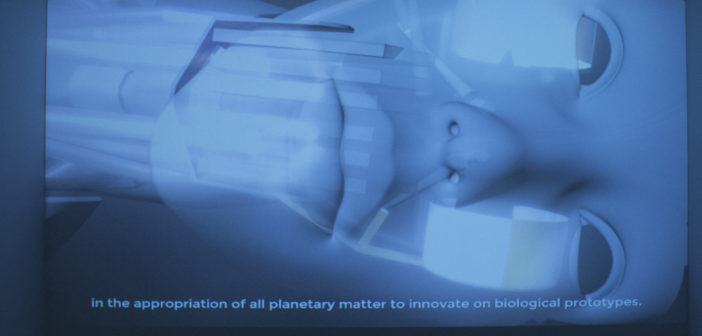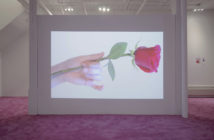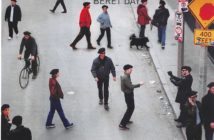“What is radical in 2016-2017?” artist, activist, educator Morehshin Allahyari asked the audience in attendance for her talk “On Activism, Digital Colonialism, and Re-figuring” at UMass Lowell last Wednesday afternoon. Born in Iran and a resident of the US since 2007, Allahyari literally toggles political and literal boundaries as much as her work with new media addresses the nuances of collective memory, national myth, pedagogy, and poetics. Solid State Mythologies at UMass Lowell’s University Gallery presented recent projects addressing techno-capitalism and petroleum products and their correlation to war, violence, censorship, and neo-nationalism. In each project, Allahyari engages the digital technologies—be it the Internet, 3D printing, or video—to re-address rationalism and history, thereby radicalizing the future.
Absurdism conceptually seams Solid State Mythologies. “We were drawn towards the politically relevant, yet playful way she uses emerging technologies,” co-curators and artists Misha Rabinovich and Caitlin Foley tell me. For instance, in “Dark Matter,” Allahyari’s first series with 3D printing, objects ubiquitous in the West but banned in Iran are amalgamated together in dark, dense resin. These combinations of Barbies, VHS tapes, dildos, dogs and Homer Simpson are illogical, but are however rational juxtapositions; their unification possible through both their popularity and taboo. Black with unrefined surfaces—not crude, but subtly unfinished—these objects’ effect is that they cohere through thick black oil, the very matter that so fraught fully unites the West and the Middle East. 3D printing isn’t a tool for creating ‘real’ or utilitarian objects, then, but a process through which to re-imagine the possible based on the absurdity of political reality.
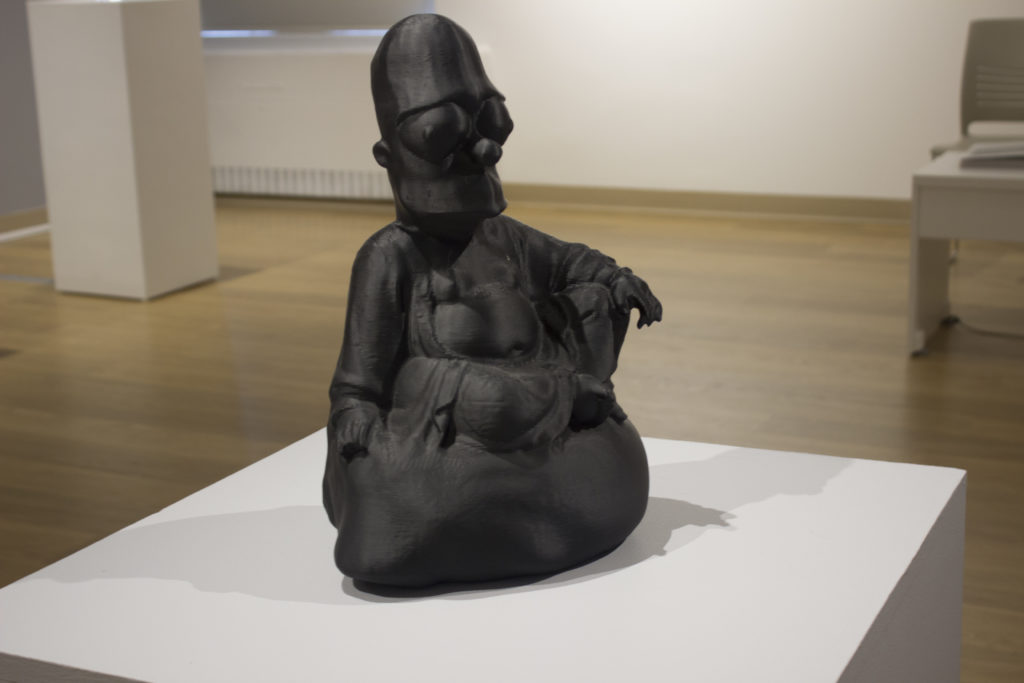
#buddha #Simpson, 2014 (large). 3D printed plastic resin. 16 x 10 x 7.5 inches (approx.) 1 of 1.
First spurred to explore 3D printing after Cody Wilson launched his printed gun, Allahyari maintains that there is nothing radical about violence, and she is correct. Fear and isolationism inspire “wiki weapons” in the US as much as they do literal armament in the Iraq and Iran. Destruction of one’s enemies via their cultural heritage is likewise a tradition on both sides (think US forces symbolically toppling Saddam Hussein’s statue in 2003 or destruction of ancient artifacts by ISIS). “Destruction of cultural heritage isn’t new, documentation and sharing of it is,” said Allahyari during her talk. Radical resistance, then, is the re-imagination of documentation of banal brutality.
“Material Speculation: Isis” (2015-2016) reimagines, via digital images, personal memories, and collective histories, artifacts destroyed at Iraq’s Mosul Museum by ISIS. A series of twelve small sculptures printed in clear plastic, each piece is modeled through Allahyari’s research, including correspondence with scholars and Mosul Museum curators, all of which is stored on a thumb drive within. Located in northern Iraq, close to the borders of Syria and Turkey, historically Mosul, and nearby Hatra, were cities of cultural confluence, and the Mosul Museum housed important Hatrene artifacts. These objects—of particular significance because of their convergence of Eastern and Western styles—included statues of Hatrene nobility that ISIS considered “idolatrous.” At UMass Lowell, Rabinovich and Foley lit all four on view from within, creating a glow, a poetic parallel to speed of light and the nuance of digital translucence that Allahyari manipulates for each.
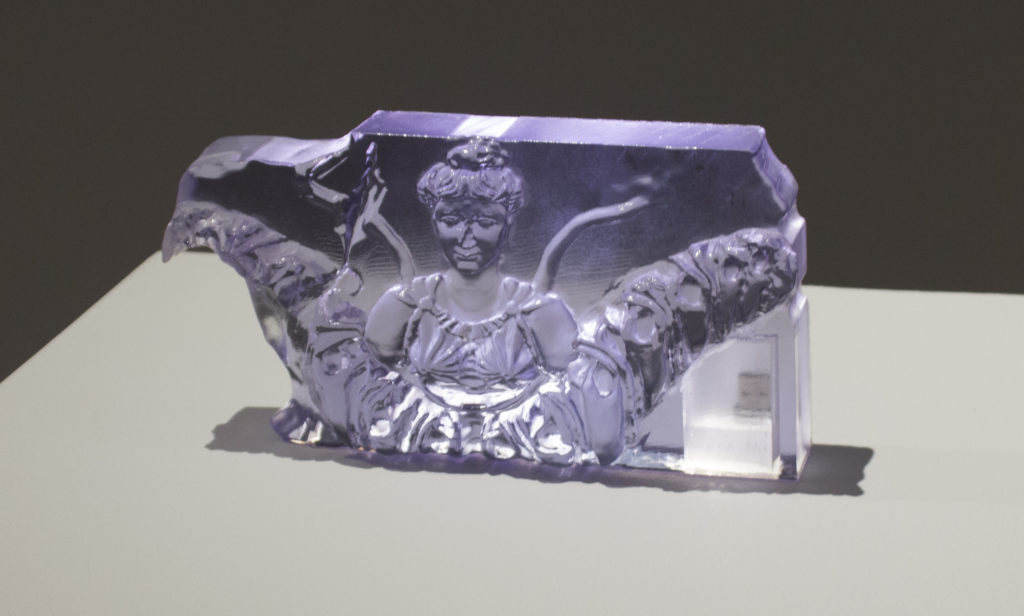
Marten, 2015. 3D printed plastic and electronic components. 4.5 x 9 x 1 inches.
Recreation of these objects reveals the power of personal archive and the continuing reverberations of Colonialism in the digital age. Owing to decades of chronic underfunding, the Mosul Museum didn’t have complete archives of images of the destroyed artifacts. Online images of the untouched statues were scant. These artifacts only endure within personal memories and archives forcefully abridged as a consequence of Colonialism.
Allahyari was impelled to reconstruct these statues particularly after seeing how Western tech companies sought to rebuild them via proprietary software. Such techno-capitalists, mostly organizations in the West or with Western funding, travel to places like Mosul to scan artifacts at risk of destruction. These companies exploit the idealism of techno-utopianism but privately retain the data from these scans. For Allahyari, these companies are effectively looting these archives, taking their images and recreating them for private use. Art and artifacts destroyed by ISIS have been recreated through 3D printing across the West, like so many digital equivalents of the British Museum’s Elgin Marbles.
Oil is a “lubricant of historical and political narratives,” said Allahyari in her talk as she discussed “The 3D Addivist Manifesto,” created in collaboration with Daniel Rourke. Gracefully installed in Solid State Mythologies, this video confronts the metaphysics of oil, employing a Futurist, dystopian aesthetic. Stylized in a sort of vintage sci-fi, the video is simple and pixelated but visualizes a biotech present in which oil and its derivative, plastic, is used to change the world by adding more into the topography of tech. An ocean of oil is speckled with detritus, from Duchamp’s “Fountain” (1917) to DNA and an oil pump jack. A roboticised voice with a third culture accent speaks bluntly:
From the black oil of a trillion ancient bactrioles the plastic used in 3D additive manufacturing is a metaphor before it has even been layered into shape…Creation must be a violent assault on the forces of matter, to extrude its shape and extract its raw potential.
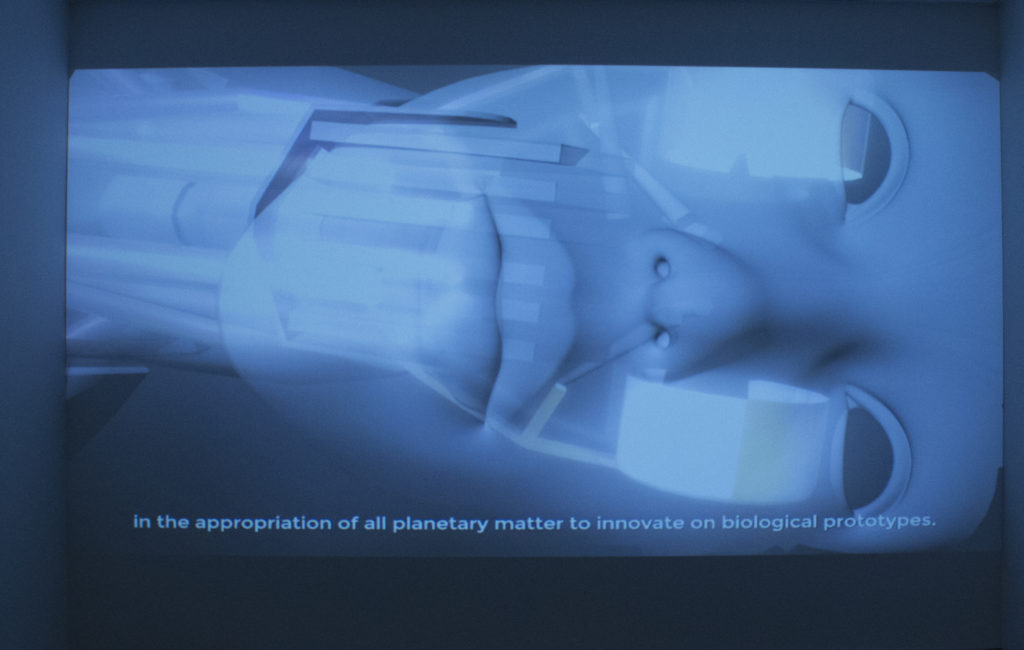
The 3D Additivist Manifesto. Morehshin Allahyari & Daniel Rourke with sound design from Andrea Young. Single channel video, 10 minutes 11 seconds, 2015.
Allahyari is so attuned to systems, language, and their relationship to new media, so it confused me to hear her co-opt the language of violence (“call to arms,” an “army of female figures”) during her talk in describing her work. Was this purposeful, a sort of reclamation? Or was this evidence of how such language seeps into colloquialism?
But then war and global conflict is very much part of Allahyari’s reality. Just weeks before her talk, the current president ordered the travel ban, affecting Allahyari’s ability to come back to the US from Germany with her green card. “Luckily changes instated to the executive order regarding green card holders as well as the judicial block of the ban made it possible for Morehshin to return on schedule,” wrote Rabinovich and Foley to me, “however, this travel ban, as well as another imminent executive order, poses larger challenges that are highly concerning for an international institution.”
Fluidity and exchange of ideas and information are foundational to free societies and open institutions. But intellectualism and globalism are very much under threat, making it imperative to vigilantly consider systems of power in the dissemination of information. Allahyari referenced a Donna Haraway quotation several times in her talk, pointed to it as a guide to her current work of radical “re-figuration.” From 20152015, the quote reads like a conduit for resistance and re-imagination of our future from the current moment. Haraway writes, “It matters which stories tell stories, which concepts think concepts. Mathematically, visually, and narratively, it matters which figures figure figures, which systems systematize systems."
Solid State Mythologies was on view through February 28, 2017. Allahyari is currently a resident of Eyebeam.

